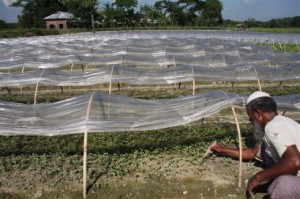BANGLADESH AGRICULTURE: Battling the effects of climate change

DHAKA, 16 December 2008 (IRIN) – Bangladesh urgently needs support in developing a climate-resilient agriculture if its people are to survive and prosper in the long term, according to some experts.
Climate change is affecting the country in many ways. For instance, rising sea levels are causing some agricultural land in coastal areas to become more saline, reducing both the quality and quantity of the produce available.
In southern districts where land is only centimetres higher than the brackish estuarine water, large swathes of agricultural land are becoming arid: Crop yields are shrinking as a result of increased salinity due to rising water levels in the Bay of Bengal.
Agronomists and agricultural experts now worry that creeping salinity will engulf more and more land in the low-lying nation.
“The impact of climate change on agriculture is undeniable and will most certainly worsen if governments and donors fail to take appropriate steps right now,” Ghulam Mohammad Panaullah, former research director of the Bangladesh Rice Research Institute (BRRI), warned.
In coastal areas, cocoa nut and betel nut trees do not yield half of what they did two decades ago, while banana groves are dying out in their hundreds, Panaullah told IRIN.
At the same time, vegetables sold in the urban markets of Dhaka, Khulna and Rajshai are deemed tasteless and fetch low prices compared to produce from salt-free regions.
Climate-resilient agriculture
In a country where almost 80 percent of the population lives in rural areas, this is bad news.
According to the World Bank, Bangladesh’s agriculture sector accounts for about 22 percent of gross domestic product (GDP), with another 33 percent of GDP is derived from the rural non-farm economy, which is also linked to agriculture. Around 54 percent of the rural population is employed in agriculture.
Bangladesh needs support for climate-resilient agriculture, ActionAid said in a report at the UN climate change summit in Poznan, Poland, which ended on 12 December.
Citing an Intergovernmental Panel on Climate Change (IPCC) report which said South Asia might experience a 30 percent drop in agricultural production by 2050, ActionAid said the slide was already evident.
Food price volatility, which could be compounded by increasing climate change variability, is likely to be a serious problem for the foreseeable future, according to ActionAid.
The report said support for sustainable climate-resilient agriculture was key to enabling farmers to increase food security and adapt.
New techniques
Meanwhile, in an effort to address this, farmers have taken to raising their vegetable beds, maintaining the soil’s moisture by covering the seed beds (and the manure around plants) with straw and leaves to prevent excessive evaporation and erosion, and increasing the amount of organic material in the soil.
Others are modifying their cropping patterns altogether, the report said.
“Bangladesh is one of the worst affected among countries that are facing the early impacts of climate change,” said A.K.M. Rezaul Kabir, secretary in the Ministry of Environment and Forestry.
In 2005 the government prepared a National Action Plan on Adaptation (NAPA) identifying 15 projects that needed to be undertaken, but “unfortunately three years have already passed and we have only just started implementing the first project,” the official said.
Climate risk index
Bangladesh tops the Global Climate Risk Index 2009, followed by North Korea and Nicaragua.
Launched at the UN climate change conference in Poznan on 4 December, the index lists 170 countries and was drawn up by international NGO Germanwatch.
Natural calamities in Bangladesh led to the deaths of 4,729 people last year, and the average loss of property in Bangladesh due to natural disasters was over US$4 billion per year, the NGO said.
These changes are already having major impacts on the economy and on the lives and livelihoods of millions of poor people, according to a World Bank report.
It said predicted rainfall increase, particularly during the summer monsoon, could increase flooding in more vulnerable areas in Bangladesh.
In the longer term, global warming could lead to the disappearance of many glaciers that feed many rivers in South Asia, the report said.
“If that happens, green Bangladesh would turn into a grey desert and most people would die of starvation,” predicted Mosharraf Hossain, a former parliamentarian from the coastal district of Laxmipur.
Source: http://www.irinnews.org/report/81978/bangladesh-battling-the-effects-of-climate-change


